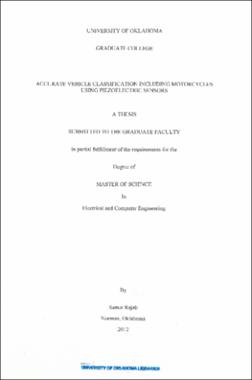| dc.contributor.author | Rajab, Samer | |
| dc.date.accessioned | 2021-11-09T18:00:16Z | |
| dc.date.available | 2021-11-09T18:00:16Z | |
| dc.date.created | 2012 | |
| dc.date.issued | 2012 | |
| dc.identifier.uri | https://hdl.handle.net/11244/331237 | |
| dc.description | Thesis (M.S. ECE)--University of Oklahoma, 2012. | |
| dc.description | Includes bibliographical references (leaves 88-90). | |
| dc.description.abstract | State and federal departments of transportation are charged with classifying vehicles and monitoring mileage traveled. Accurate data reporting enables suitable roadway design for safety and capacity. Vehicle classifier devices currently employ inductive loops, piezoelectric sensors, or some combination of both, to aid in the identification of 13 Federal Highway Administration (FHWA) classifications. However, systems using inductive loops have proven unable to accurately classify motorcycles and record pertinent data. Previous investigations undertaken to overcome this problem have focused on classification techniques utilizing inductive loops signal output, magnetic sensor output with neural networks, or the fusion of several sensor outputs. Most were off-line classification studies with results not directly intended for product development. Vision, infrared, and acoustic classification systems among others have also been explored as possible solutions.
This thesis presents a novel vehicle classification setup that uses a single piezoelectric sensor placed diagonally on the roadway to accurately identify motorcycles from among other vehicles, as well as identify vehicles in the remaining 12 FHWA classifications. An algorithm was formulated and deployed in an embedded system for field testing. Both single element and multi-element piezoelectric sensors were investigated for use as part of the vehicle classification system.
The piezoelectric sensors and vehicle classification system reported in this thesis were subsequently tested at the University of Oklahoma-Tulsa campus. Various vehicle types traveling at limited vehicle speeds were investigated. The newly developed vehicle classification system demonstrated results that met expectation for accurately identifying motorcycles. | |
| dc.format.extent | vii, 107 leaves | |
| dc.format.medium | vii, 107 leaves : ill. ; 29 cm. | |
| dc.language.iso | eng | |
| dc.subject.lcsh | Motor vehicles--Classification | |
| dc.subject.lcsh | Motorcycles | |
| dc.subject.lcsh | Piezoelectric devices | |
| dc.title | Accurate vehicle classification including motorcycles using piezoelectric sensors | |
| dc.type | Text | |
| dc.contributor.committeeMember | Cheng, Samuel | |
| dc.contributor.committeeMember | Verma, Pramode | |
| dc.contributor.committeeMember | Refai, Hazem | |
| ou.group | School of Electrical and Computer Engineering | |
